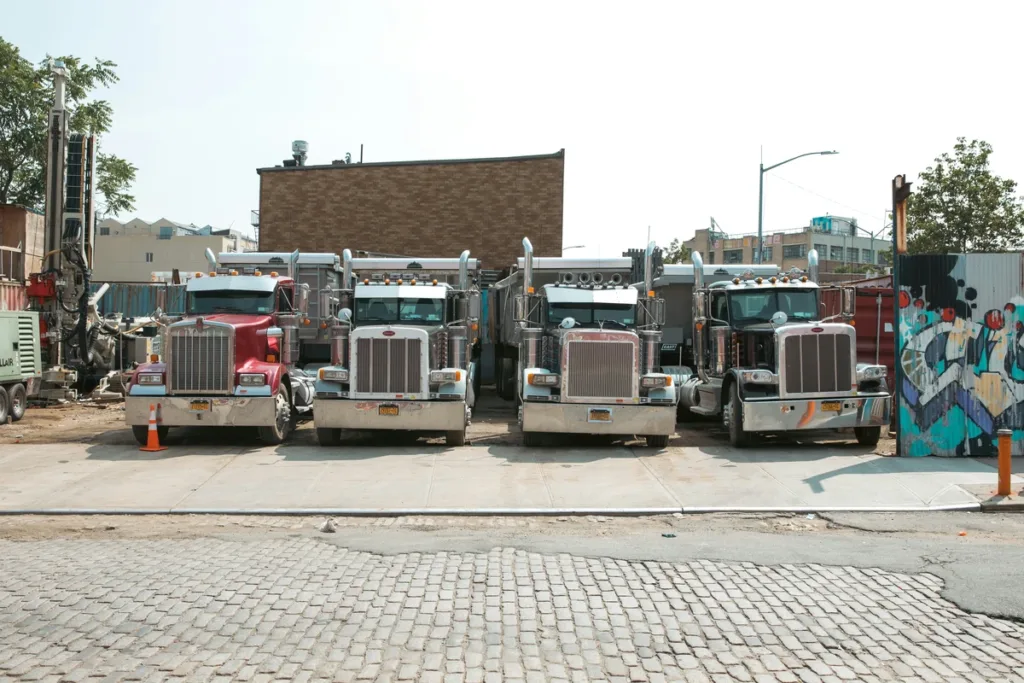What is a Level 2 DOT Inspection?
A Level 2 DOT inspection is one of the six levels of inspections conducted by the Department of Transportation (DOT) to ensure the safety and compliance of commercial motor vehicles (CMVs) and their drivers. It is known as a “Walk-Around Driver/Vehicle Inspection”, meaning it’s less extensive than a Level 1 inspection but still thorough enough to check for critical violations.
Unlike a Level 1 DOT inspection, where inspectors physically get under the vehicle to inspect its undercarriage and braking system, a Level 2 inspection focuses on external checks and driver-related documentation. For CDL businesses, preparing for this inspection is crucial to avoid costly violations and maintain a good safety rating.
If you’re wondering, “What is a Level 2 DOT inspection?”, this guide will cover everything you need to know, from the checklist to practical tips for passing it successfully.
What is the Difference Between Level 1 and Level 2 DOT Inspections?
While both the Level 1 and Level 2 inspections involve comprehensive vehicle and driver checks, the primary difference lies in the depth of the inspection.
A Level 1 DOT inspection is the most detailed and requires inspectors to check under the vehicle, review the driver’s paperwork, and conduct a complete inspection of key mechanical components.
In contrast, a Level 2 inspection is a “walk-around” inspection where the inspector checks for compliance and visible defects without crawling under the vehicle. While it may seem less intense, it’s still a thorough process that can result in fines if violations are found.
If you’d like to learn more about Level 1 inspections, visit our guide on Level 1 DOT Inspection for a full checklist and tips to prepare your fleet.
DOT Level 2 Inspection Checklist

To pass a DOT level 2 inspection, it’s important to understand the key components that inspectors will evaluate. Here’s a breakdown of the DOT level 2 inspection checklist:
Driver-Related Inspection Items
- CDL License: The driver’s Commercial Driver’s License (CDL) must be valid, up-to-date, and appropriate for the vehicle being operated.
- Medical Card: The driver must provide a current medical certificate that proves they are medically fit to operate a CMV.
- Hours of Service (HOS) Logs: The inspector will check the driver’s HOS records to ensure they are within legal driving limits. Logs must be complete, up-to-date, and accurate.
- Pre-Trip Inspection Reports: Drivers are required to complete pre-trip inspections to identify and address vehicle issues before trips. Inspectors may ask for these reports.
- Drug and Alcohol Testing Compliance: The driver must be compliant with DOT commercial driver drug testing policies, especially if they’ve recently started a new role.
LEARN MORE: DOT Inspection Form Instructions
Vehicle-Related Inspection Items
- Lights and Reflectors: Headlights, taillights, brake lights, turn signals, and reflectors must be operational and visible.
- Tires and Wheels: The inspector will look for tire damage, proper inflation, and sufficient tread depth. Wheels and rims should be in good condition, free of cracks or defects.
- Brakes: While the inspector will not check the internal braking components, they will observe external indicators like brake lights and air brake system pressure.
- Emergency Equipment: The vehicle must have fire extinguishers, spare fuses, and reflective triangles to comply with DOT safety requirements.
- Exhaust and Fuel Systems: Inspectors look for visible signs of fuel or exhaust leaks, as these can pose a serious safety hazard.
- Steering and Suspension: Inspectors visually check for issues with the steering wheel, suspension springs, and shock absorbers.
ALSO: DOT Inspection Sticker Requirements, Placement, & More!
How to Prepare for a Level 2 DOT Inspection

Preparation is the key to passing a level 2 truck inspection. Here’s how CDL businesses and drivers can get ready:
Conduct Regular Pre-Trip Inspections
Train drivers to perform daily pre-trip inspections and document their findings. Identifying and resolving issues early prevents problems from escalating. This proactive approach reduces the risk of violations during an inspection.
Ensure Accurate Driver Documentation
Make sure drivers have access to their CDL, medical card, and HOS logs. If documentation is missing or incomplete, it can result in an Out-of-Service (OOS) violation, which impacts the company’s Compliance, Safety, and Accountability (CSA) score.
Prioritize Vehicle Maintenance
Routine maintenance is essential for passing a DOT inspection level 2. CDL companies should schedule regular maintenance to check lights, tires, and brake systems. Any visible issues can be flagged during a walk-around inspection.
Train Drivers on Inspection Expectations
Drivers should know what to expect during a level 2 inspection and be prepared to answer questions from inspectors. Training programs that explain the inspection process and teach drivers how to maintain proper documentation can increase the chance of a successful inspection.
RELATED: DOT Inspection Form Instructions
Common Violations Found During a DOT Level 2 Inspection

Even though a DOT level 2 inspection is less intensive than a Level 1 inspection, violations still occur. Here are some of the most common issues that inspectors find:
- Defective Lights: Burnt-out brake lights, turn signals, and headlights are frequently cited violations.
- HOS Log Violations: Incomplete or inaccurate hours-of-service logs result in immediate violations.
- Tire Issues: Bald tires, low tire pressure, or visible damage can result in an Out-of-Service violation.
- Missing Emergency Equipment: If the vehicle doesn’t have a fire extinguisher, reflective triangles, or spare fuses, it may fail the inspection.
- Driver Documentation Errors: Missing or expired medical cards, licenses, and pre-trip inspection reports can trigger violations.
By addressing these issues before an inspection, CDL companies can avoid penalties and maintain a positive CSA score.
How Driver Files Online Supports CDL Companies

Driver Files Online helps CDL companies stay ahead of compliance deadlines and inspection requirements. Our platform offers essential tools to streamline driver qualification, recordkeeping, and regulatory compliance.
Streamlined Driver Applications
Our online driver application portal helps CDL companies collect and organize DOT-compliant applications. This ensures all driver details are accurate, complete, and ready for review.
Access to PSP Reports
Driver Files Online provides access to Pre-Employment Screening Program (PSP) reports, which include a driver’s five-year crash and three-year inspection history. This helps employers hire safer, more qualified drivers.
Managed Services for Background Checks
Our managed services handle time-consuming employment verifications, ensuring companies meet DOT requirements efficiently. This allows businesses to focus on operations while we take care of compliance tasks.
File MVR Reports
Driver Files Online delivers State Motor Vehicle Reports (MVRs) directly to your driver’s file, providing essential information to maintain compliance and make informed hiring decisions.
Automated Compliance Reminders
Our automated system sends timely reminders for license renewals, medical certifications, and other regulatory deadlines. This ensures CDL companies avoid missed deadlines and potential fines.
By getting started with Driver Files Online, CDL companies can focus on growing their business while ensuring regulatory compliance is never overlooked. View our pricing to see what fits your needs!
Stay Ready for Your Next Level 2 DOT Inspection

Preparing for a Level 2 DOT inspection is crucial for CDL companies to maintain compliance and avoid costly penalties. By following the DOT level 2 inspection checklist, keeping up with maintenance, and properly vetting drivers, companies can reduce violations and maintain a strong safety record.
Driver Files Online supports CDL companies by simplifying the hiring process, ensuring compliance, and managing essential deadlines. Ready to streamline compliance for your business?
Sign up to see how Driver Files Online can help you prepare for your next inspection.
Disclaimer:
This article is for informational purposes only. Always check FMCSA regulations for the most up-to-date inspection requirements.
Frequently Asked Questions: Level 2 DOT Inspections
What is a level 2 inspection?
A Level 2 inspection is a “walk-around” inspection where the inspector evaluates both driver and vehicle compliance. Unlike a Level 1 inspection, the inspector does not check under the vehicle.
What is the difference between a level 1 and level 2 inspection?
A Level 1 inspection is more comprehensive and includes under-vehicle inspections. A Level 2 inspection is a “walk-around” inspection, with a focus on external components and driver documentation.
What happens if you fail a level 2 DOT inspection?
Failing a Level 2 inspection can result in Out-of-Service (OOS) orders, fines, and a negative impact on the company’s CSA score.
PEOPLE ALSO ASK: How Much Does an IFTA License Cost?
